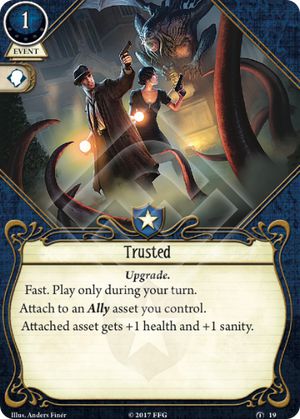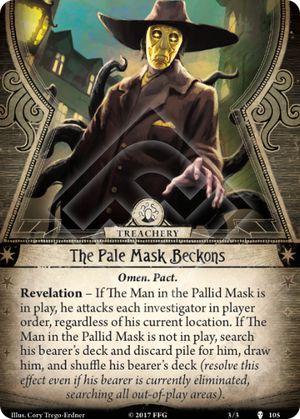
This card DESTROYED us. The fact this is 3 damage AND lose 3 action easily makes it one of the most powerful treacheries in the game. Definately have a mystic carry Ward of Protection or Deny Existence if you play Carcossa.

This card DESTROYED us. The fact this is 3 damage AND lose 3 action easily makes it one of the most powerful treacheries in the game. Definately have a mystic carry Ward of Protection or Deny Existence if you play Carcossa.

One of the "take a bunch of damage and.or horror" signature weaknesses, unusual for being randomized. Looking at the two elements, the effect and the discard condition, we get:
The effect: You take 0-4 damage and horror, which is unlikely to kill Jim, but it's unpleasant, as it can lose a scenario or campaign and/or net you a Trauma if you are unlucky. The 3 campaigns that make Jim more powerful makes this more deadly, which is a nice balance. Olive McBride can mitigate it (or make it worse), and Dark Prophecy can help. Sadly, Eldritch Inspiration is no help at all. I guess Jacqueline could help out, but what is the chance of Jim and her being in the same scenario?
The discard condition: You draw it, it's Revelation effect happens, you discard it. Simple, but it can happen multiple times, if you deck yourself or play Quantum Flux.
All in all, this is an average signature weakness, maybe a bit above in some campaigns/scenarios.

One of those signature Weakness that can end the Campaign. Looking at the two elements, the effect and the discard condition, we get:
The effect: Draw an enemy, then someone has to kill it by the end of the scenario or Zoey gets hurt. The nasty sting is that if Zoey is taken out by damage or horror, she ends up with 2 Trauma for her troubles. If you are unlucky enough to have this happen a couple of times, it's new investigator time. Fortunately, unlike Searching for Izzie, this card asks you to do what Zoey always wants to do.
The discard condition: Well, you discard it when the enemy gets killed, which is exactly what Zoey wants to do. It can be extremely variable, since you can draw a Swarm of Rats or a Servant of the Lurker. Drawing an Aloof enemy is, of course, extra annoying. It also benefits from the "loophole" that anyone can resolve it, so if a very weak enemy comes out or another investigator is combat-ready, this can be dealt with pretty easily. As usual with this style of Weakness, when you draw it is critical, as is the map. Drawing it one turn before Resigning or dooming out in The Unspeakable Oath is way worse than drawing it early in The Secret Name. It can take anywhere from 2 to 6+ actions to clear, so it is a very situational weakness. You can mitigate the effects with "Get over here!" or Righteous Hunt.
All in all, this is an above average signature weakness, maybe average if all of the investigators are combat-ready.

The best use of trusted is probably betrayal. The second best use is keeping Survivor allies that heal themselves alive when the encounter deck does one damage or one horror to allies. But the best use hasn’t been mentioned yet in reviews, and that’s to reload Becky.
For a measly one resource, a card, zero actions and zero XP, you can make your disposable allies that much tougher. And then you kill them off, which if you’re building Tommy right you will. (Between Tetsuo, solemn vow, or even self-sacrifice, you should be cycling allies regularly.) And one damage and one horror means two more bullets in a gun that perpetually seems out of bullets.
Even better, it’s two more damage if you plan on the level two guard dog and space things out, turning the pupper into a 5/3 powerhouse. With this card, officer Muldoon can turn trust into a one-way street.

Someone pointed out that this has a wonderful interaction with counterpunch and guard dog (as well as their upgrades). Instead of going across the map to fight the stranger, it’s possible to defeat him because of the attacks he makes on you. The Pale Man may beckon, but Nathaniel the boxer sees a hand start to move and drops a hook right to the jaw. See you in the dreams!